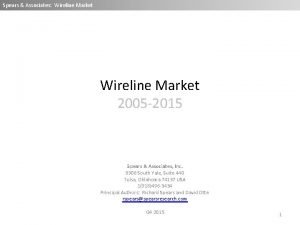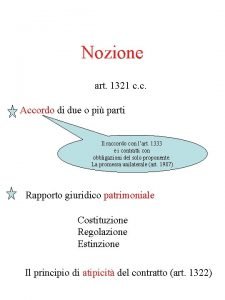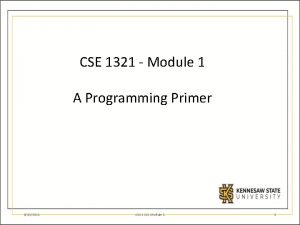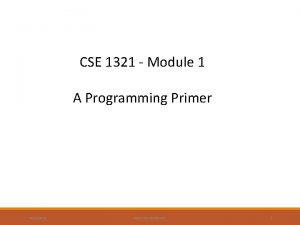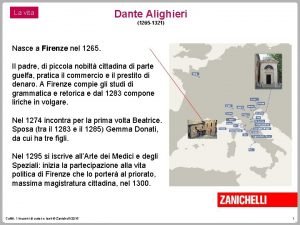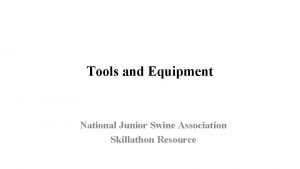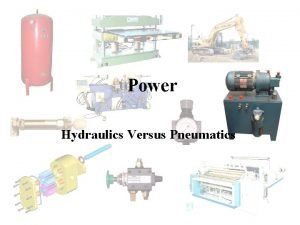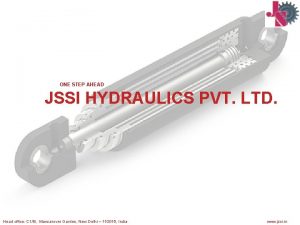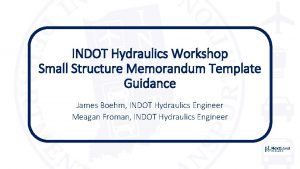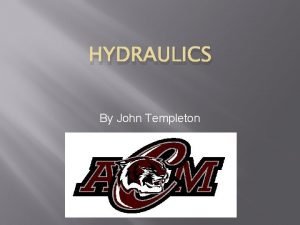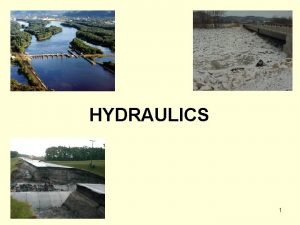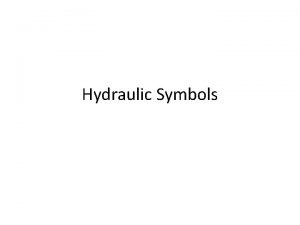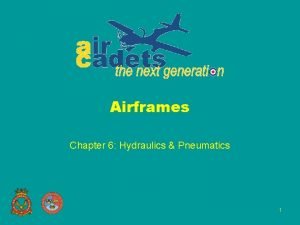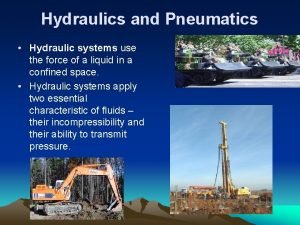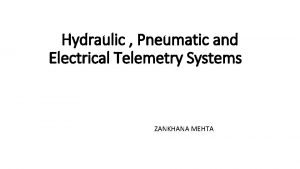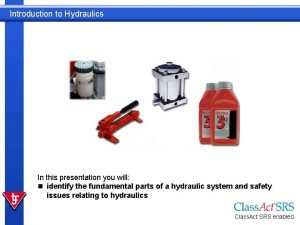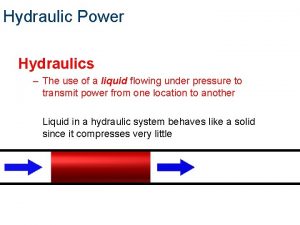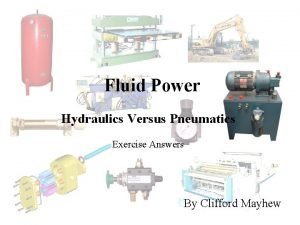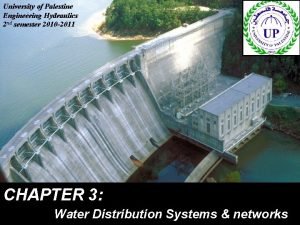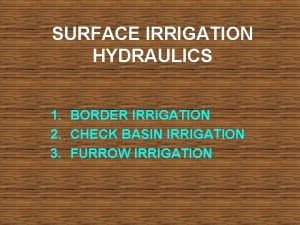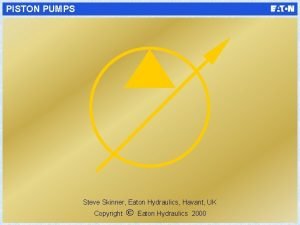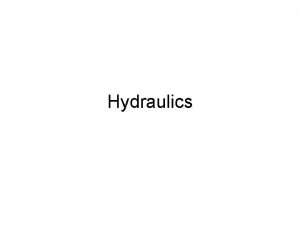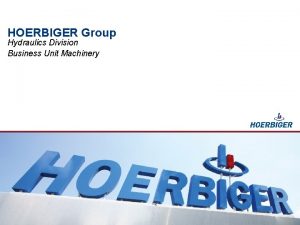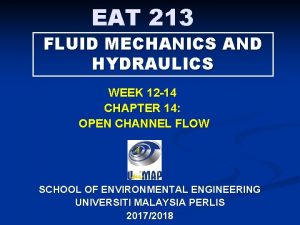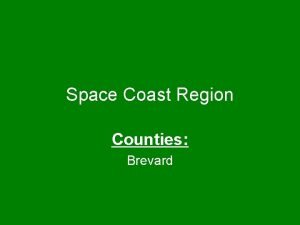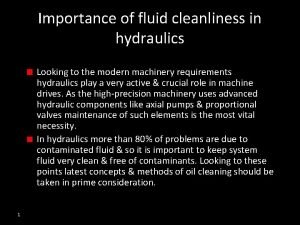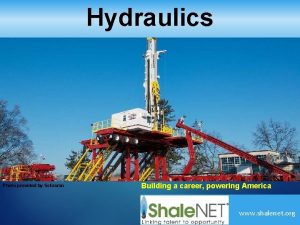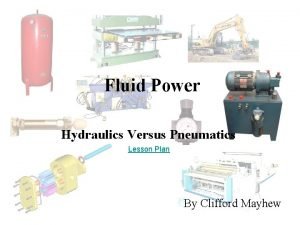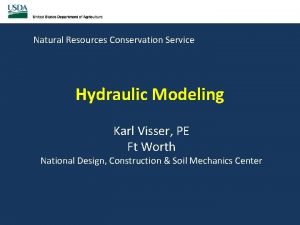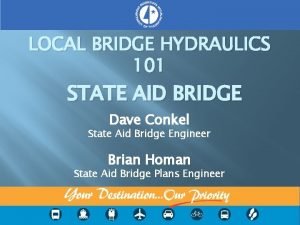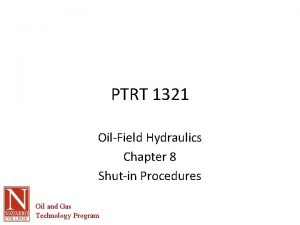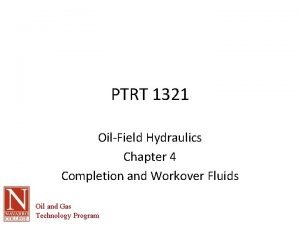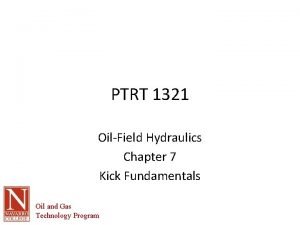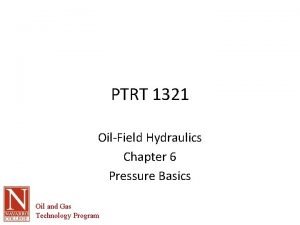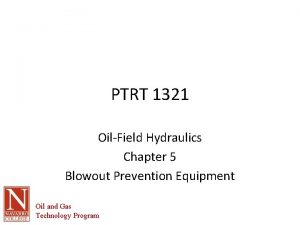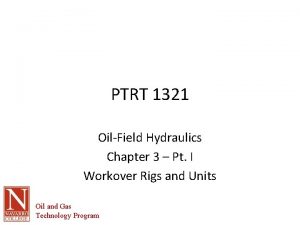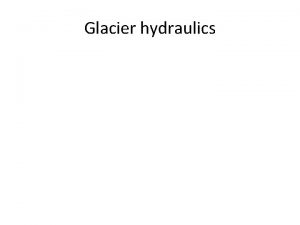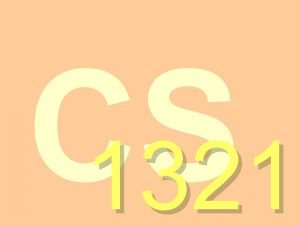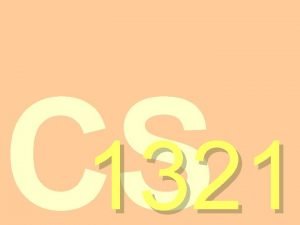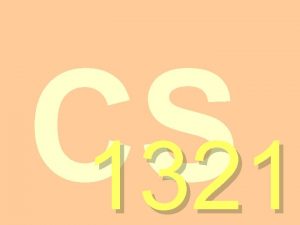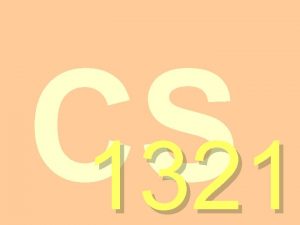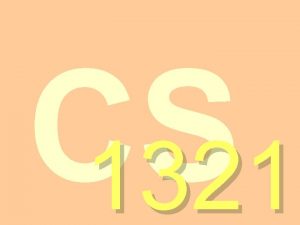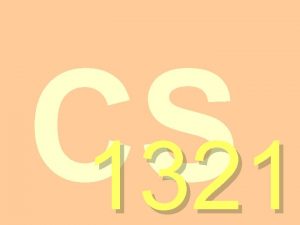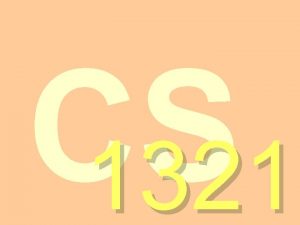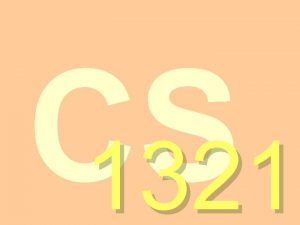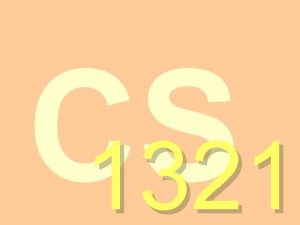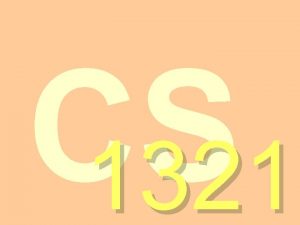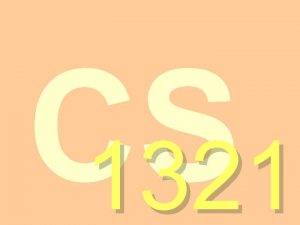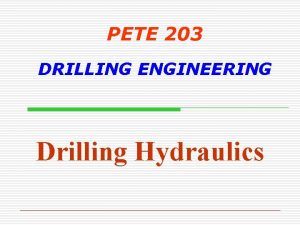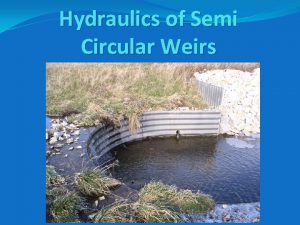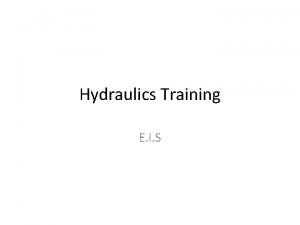PTRT 1321 OilField Hydraulics Chapter 2 Production Equipment








































- Slides: 40

PTRT 1321 Oil-Field Hydraulics Chapter 2 Production Equipment Oil and Gas Technology Program

Introduction • Many devices and tools used in a producing well • Installed on the surface – – – Control panels Injection pumps Control lines Flow couplings Safety valves • Installed below the surface – – – Safety valves Mandrels Packers Landing nipples Subs Guides Oil and Gas Technology Program

Typical sub-surface equipment Some equipment is permanently installed Some installed only during workover Some equipment is run in as part of the original string Some run in on tubing or wireline Oil and Gas Technology Program

Christmas Tree (Well Head) • Mechanical structure • • Spools Flanges Connections Hangers • Control of fluid flow and pressure – Valves – Chokes – Pressure gauges • Carelessness can prove fatal Oil and Gas Technology Program

Oil and Gas Technology Program

Component Descriptions 1. Pressure gauges – display tubing, casing or annular pressures 2. Gauge flange (cap) – seals the top of the tree (often a hammer fitting). Remove to allow access to the well for wireline, coil tubing or other workover units. 3. Crown (swab) valve – isolate the well to allow access through cap 4. Flow (cross) tee – allows tools to be run into the well while still producing 5. Wing valve – shuts in the well for most routine operations not requiring access to the well bore Oil and Gas Technology Program

6. Choke – controls the amount of flow from the well 7. Master valves – primary shut off valves, open most of the life of the well, lowest master valve used as last resort to avoid wear and tear 8. Tubing hanger – supports the tubing string and seals off the casing annulus 9. Casing valve – provides access to the annular space between the tubing and the casing 10. Casing hanger – slip and seal assembly from which the casing is suspended 11. Casing – string of pipe the keeps the wellbore from caving in and prevents vertical communication from one zone to another. 12. Tubing – string of pipe through which produced fluids flow Oil and Gas Technology Program

Back-pressure valves • Installed into the tubing hanger • Two types available – One-way check valve • Flow only into the well – Two way check valve • Holds pressure in either direction • Allow Christmas tree to be removed or replaced without having to kill the well Oil and Gas Technology Program

Type H Back Pressure Valve Oil and Gas Technology Program Type H Two-way Check Valve

Christmas Tree Removal • Careful planning is a must • Consider the following questions: 1. Is the tree to be removed before or after the rig is moved in? 2. Will service on the tree (if required) be at a shop or in the field? 3. Is the manufacturer rep present and are spare parts available on site? 4. Is the BOP equipment ready to be installed? 5. Is the well to be killed or worked on under pressure (live) Oil and Gas Technology Program

Christmas Tree Removal (cont) • Other considerations: 1. All exposed flanges should be protected and all BOP flanges should be inspected and cleaned prior to use 2. New seal rings should be available as metal seal rings cannot be reused 3. Tubing and casing pressures should be checked with gauges KNOWN to be working. 4. If the well is being killed the casing should be installed and cemented properly 5. No communication between the casing and tubing should exist. All points of failure should be repaired Oil and Gas Technology Program

Removing the well head • Kill the well by bullheading kill fluid into the formation – Pumping fluid down the tubing and displacing the formation fluid back into the formation – Calculate the tubing volume and note when that much kill fluid has been pumped • A few interesting notes: – Clear fluids can fall faster than they can be pumped (pressure will drop) – Gas migrates faster than it is bullheaded – Too much fluid pumped down hole can cause formation damage – Increase in pump pressure should signal that the kill fluid has reached the bottom Oil and Gas Technology Program

Finishing steps • Record the volume pumped and the pressures • Shut in the well and check for pressure build up for about 1 hr • Have a full opening valve available with proper threads and sized to fit the tree • If no pressure build up occurs remove the tree and install a BOP stack Oil and Gas Technology Program

Casing • Steel pipe that runs from surface to specified depth in well (4 1/2 to 20 inches) • Hangs from casing hanger and cemented into the hole • Several casings can be used to reduce cost • Casing prevents lost circulation and comingling of well fluids • Foundation for surface equipment Oil and Gas Technology Program

Liners • Casing hung inside an existing casing • Hangs from liner hanger installed near the bottom of the casing in which the liner is run • Many reasons to use a liner – Cost – Isolate problems from other zones such as lost circulation • Handling issues same as casing Oil and Gas Technology Program – Inspect and careful handling – Thread protectors removed only prior to stabbing the joint – Sometimes a stabbing guide is used to prevent cross-threading

Liner hanger • Supports the liner near the bottom of the last string of casing • Both grip the inside of the casing • Mechanical slips (j-slot and rotation) • Hydraulic slips (hydraulic pressure pushes the slips outward) Oil and Gas Technology Program

Oil and Gas Technology Program

Tubing • Majority of wells are produced through tubing • Protects casing from pressure and corrosion • Tubing is suspended from the well head • Sizes from fractions of an inch to several inches (2 7/8 and 2 3/8 common sizes) • Strength classifications such as J-55 or N-80 • Also available with protective coatings applied for corrosion protection Oil and Gas Technology Program

Work Strings • Length of tubing or drill pipe used for workover or completion • Can be the production tubing or replace the production tubing with drill pipe • In either case tubing is removed, tools installed on the end and the tubing is run back in the hole • Of course the OD must be small enough to fit into the well without restriction Oil and Gas Technology Program

Packers • Seals the annular space between the tubing and the casing • Protects the casing from pressure and reservoir fluids • Multiple packers isolate multiple completions to prevent commingling • Special packers are also available for squeeze cementing, acidizing and fracturing • Often a gauge run is made (scraper and junk basket) to confirm full size through the length Oil and Gas Technology Program

Packer Elastomer seal Oil and Gas Technology Program slips

Setting the Packer • Hydraulic – pump out ball seat near the bottom of the tubing provides the means to apply the setting pressure • Mechanical – packer plus a seal assembly run in on tubing to the setting depth. Upper slips are released with right-hand rotation of tubing and then lower slips are set with upward tension on the tubing • Electric wireline – electrical current sets off a small explosive charge in a setting assembly that gradually builds up gas pressure to set the packer. • Sandline or slickline – similar to wireline except concussion from a go-devil dropped into the well sets off the charge Oil and Gas Technology Program

Seal Nipples • Sometime installed in packers to prevent fluid and pressure from escaping between the tubing and the packer – Run in on bottom of tubing and inserted into packer – Latch type (locator) locks into packer so tension may be applied • Sealing elements can be redressed at the job site if needed Oil and Gas Technology Program

Anchor Seal Nipple Assembly Oil and Gas Technology Program Locator Seal Nipple Assembly

Bridge Plug • Set into casing to prevent fluid movement in the casing • Permanent or retrievable • Seals the well to provide added safety when removing the well head • Can also be set between perforations to isolate lower zone while workover is performed on upper zone Oil and Gas Technology Program

Blast Joints • Used in multiple completions • Protect section of tubing opposite upper perforations against erosion and/or corrosion from produced fluids • Abrasion-resistant steel or normal steel coated with plastic, rubber, tungsten carbide or ceramic Oil and Gas Technology Program

Safety Joints • Special large-profile threads • Quick release of tubing string from down hole equipment • Parted by reverse rotation or shearing • Used above tools that might become stuck in the hole • Allows for upper sections of tubing to be retrieve and fishing or other workover tools to be used to recover stuck sections Oil and Gas Technology Program

Sliding sleeve • Allows circulation between casing and tubing • Installed in tubing • Allows upper zone to be produced or shut off at later time • Can be used for treating or acidizing a zone • Ports can be opened and closed: • Wireline • Jarring Oil and Gas Technology Program

Mandrels • Installed in tubing that allows communication between tubing and casing at the location of the mandrel • Gas lift mandrel on which a gas lift valve is mounted • Sidepocket mandrel allows gas lift valves to be installed and removed with wireline without pulling the tubing • Other mandrels will accept plugs, subsurface control valves or downhole chokes Oil and Gas Technology Program

Landing Nipples • Small sub into which flow-control devices can be installed • ID slightly smaller that tubing ID • Seating area for pump-down and wireline flow-control devices • ID’s vary according to the tools they receive • Larger ID’s used near the surface than at bottom to allow tools with different ID’s to be set in the same string • Usually have a locking device to hold the tool in place Oil and Gas Technology Program

Seating nipples • Provide a place in which flowcontrol devices can be installed and retrieved by wireline • Can be used to set: • Blanking plugs for shutting in the well or testing the tubing string • Circulating blanking plugs • Equalizing check valves • Velocity-type safety valves • Chokes to reduce surface flowing pressures • Instrument hangers for pressure ro temperature recorders Oil and Gas Technology Program

Flow couplings • Smaller landing nipple ID causes turbulent flow above and below • Sand other solids can erode the tubing as a result • Flow couplings (collars) are installed in the tubing string above and below the landing nipple • Usually choose the same ID as the tubing Oil and Gas Technology Program

Retrievable cementer • Special mechanically-set packer • Used to do: • Squeeze cementing • High-pressure acidizing job • Well test • Does not become part of the completed well Oil and Gas Technology Program

Cement retainers • Special packers used in squeeze cementing • Set with wireline or tubing • Must be drilled or milled out • Retainer valve closes when tubing is picked up and opens when tubing is set down • Closed valve holds the final squeeze pressure as excess cement is circulated out • Also keeps hydrostatic pressure from contacting the squeezed zone in low fluid level wells during batch squeeze Oil and Gas Technology Program

Circulating washers • Used to acidize or wash perforations • Straddle-type tool with swab cups or inflatable packers that can be replaced easily at the well site • Sleeve on upper portion opens and closes circulating ports between the tubing and casing • Swab cup spacing is adjustable to the desired zone can be isolated (6” to 42” in 6” increments) • Ports are opened as tool is retrieved to allow fluid to drain from the tubing Oil and Gas Technology Program

Packer Milling Tools • Usually faster and cleaner to mill a packer’s slips and retrieve the packer than drill through • Only a small amount of the slips need to be cut to release a permanent packer • Mill is labeled A • Mill engaging the packer is labeled B • Pick up device may be run in with the mill, latches onto the packer after it is cut loose A Oil and Gas Technology Program B

Junk and Boot Baskets • Remove milled or drilled debris from a well • Circulation sweeps cuttings into an inner chamber (basket) • Heavy materials that cannot be circulated are thus caught and retrieved when the basket is retrieved. • Caution to not apply excess torque or weight or fingers of junk basket may break • Boot basket is similar but with narrow annulus to cause high velocity flow. As fluid leaves narrow annulus velocity drops suddenly causing the debris to drop vertically into the basket Oil and Gas Technology Program

Casing Scrapers • Used to remove foreign substances from casing ID • Scale • Perforating burrs • Cement • Rotated or reciprocated • Rubber blocks under the scraper blades to allow flex • Caution to not excessive wear the casing Oil and Gas Technology Program

Casing Rollers • Several rugged, heavy-duty rollers mounted on a mandrel • Rollers mounted on different centerlines • As tool rotates only one roller at a time contacts the casing • Eccentric motion can restore collapsed, dented, or buckled to its normal diameter and roundness • Operates with ample fluid circulation and slow rotation speeds Oil and Gas Technology Program

Centralizers • Used to center in the well bore: • tubing • Casing • Perforating guns • Wireline tools • For example can keep the casing centered in the hole while cementing. This allows turbulent flow needed to avoid areas Oil and Gas Technology Program
 Memasarkan produk multimedia termasuk dalam proses produksi
Memasarkan produk multimedia termasuk dalam proses produksi Spears and associates oilfield market report
Spears and associates oilfield market report Ddc directional drilling
Ddc directional drilling Lj trade
Lj trade Digital oilfield solution
Digital oilfield solution Logbook examples
Logbook examples La causa del contratto
La causa del contratto Art 1321 cc
Art 1321 cc Cse 1321
Cse 1321 Ksu fye resources
Ksu fye resources Cse 1321 slides
Cse 1321 slides Enseñanza de la parábola del sembrador
Enseñanza de la parábola del sembrador Dante alighieri 1265
Dante alighieri 1265 Cse 1321
Cse 1321 Swine sorting tools
Swine sorting tools Hydraulic vs pneumatic
Hydraulic vs pneumatic Jssi
Jssi Indot hydraulics
Indot hydraulics Hydraulics definition
Hydraulics definition Hydraulics definition
Hydraulics definition Hydraulic strainer symbol
Hydraulic strainer symbol Hydraulic advantages
Hydraulic advantages Pneumatics vs hydraulics
Pneumatics vs hydraulics Pneumatics and hydraulics basics
Pneumatics and hydraulics basics Mehta hydraulics
Mehta hydraulics Hydraulic presentation
Hydraulic presentation Hydraulics
Hydraulics Pump exercise
Pump exercise Palestine hydraulics
Palestine hydraulics Border hydraulics
Border hydraulics Eaton havant
Eaton havant Hydraulics
Hydraulics Press brake hydraulic diagram
Press brake hydraulic diagram Hydraulics
Hydraulics Space coast hydraulics
Space coast hydraulics Elc machine working principle
Elc machine working principle Professional hydraulics
Professional hydraulics Give the standard graphical symbols for frl unit
Give the standard graphical symbols for frl unit Hydraulics karl lagerfeld
Hydraulics karl lagerfeld Hydraulics 101
Hydraulics 101 Khan academy sat
Khan academy sat

